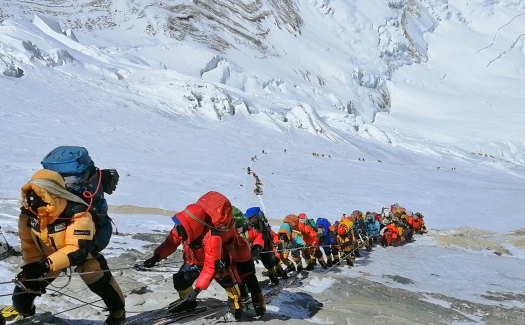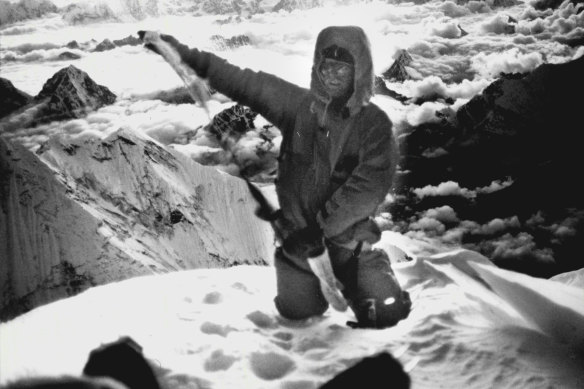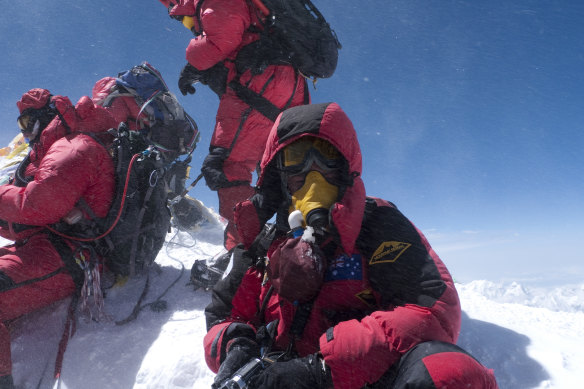This was published 2 years ago
‘We both had a cry as we hugged’: What it’s really like to climb Everest
By Tim Barlass

Jane Kanizay and daughter Gabby, 19, at the summit of Mount Everest in May 2022.
Jane Kanizay and daughter Gabby, the latter at 19 the youngest Australian to reach the summit of Everest, stood on top of the world at sunrise a year ago. They took off their oxygen masks. First, they hugged their Sherpas. Then they hugged each other. Their experience no less exhilarating than when Edmund Hillary and Sherpa Tenzing were first to reach the summit 70 years ago on May 29, 1953.
Things have changed. In some ways, the climb got easier. There’s a rope to hold on to all the way up. The equipment is more sophisticated. But queues at peak times mean climbers are spending more time above what is known as “the death zone”, that’s above 8000 metres, where the body is deprived of oxygen because the air has a third of the oxygen than at sea level.
The death of Jason Kennison on May 19 shows that Everest remains unforgiving. Kennison, who battled to walk again after a lorry crash at the age of 22, and who was well-prepared for the charity climb, died from altitude sickness – high-altitude cerebral edema or HACE, a lack of oxygen which causes the brain to swell. He is one of 10 to die on the mountain this year – five commercial climbers and five Sherpas. Two Malaysian climbers are reported missing.
Even given the dangers obvious in the number of deaths, Everest has never been more accessible. Now you can put Everest on your bucket list and tick it off during your three-week annual leave. Once a no-go zone, a bit like Antarctica, it is now a commercial destination. Everest at 8849 metres high (29,029 feet) is big business.
To climb costs $US11,000 ($16,747), which goes to the Nepalese government for the climb permit, and then you will pay another $US30,000 to $US100,000 to the commercial operator depending on size of team, support (Sherpa experience) and logistics like evacuation plans and weather forecasting.
Kanizay, a Melbourne mother of four, is an educator of dyslexic children. She made numerous preparation climbs at high altitude with Gabby in advance of their mother-daughter trip, which was organised by climbing service operator Climbing the Seven Summits.
They did the two-week walk to base camp taking in a 6000 metre peak en route to acclimatise. There were 15 in their group of eight women and seven men intending to reach the summit and the mother and daughter had their own Sherpa. Nine made it to the top; six were women. The Kanizays were the only ones in the group with a previous 8000 metre climb under their belts.
At base camp, they did what are called rotation climbs for four weeks, climbing higher each time and then coming back lower to sleep to acclimatise further. The people who didn’t summit were reaching 6500 metres before their bodies told them they couldn’t go on.
On the last night before the summit push, they camped at 7900 metres. “I left at 6.30pm and Gabby, who was faster, left at 9.30pm, and we arrived at the summit together at 4.30am to watch the sun rise. My feeling standing next to Gab was my heart bursting. We both had a cry as we hugged. You can hear the wind flapping the prayer flags up there.
“We had 30 minutes with our [supplementary oxygen] masks off. I just remember embracing the moment of being able to see 360 degrees around me the whole world. We left after about 60 minutes as we could see the next group of climbers, maybe half a dozen people, starting to arrive. For 30 or 40 minutes there were 11 of us who were the highest people on earth.”
The worst experience, she says, was going back down passing so many climbers on their way up despite it being a “quiet season” with a little over 300 permits issued for the year.
“This year, they have issued 478 permits ... That’s [roughly] half as many people again vying to get to the summit. We think there were 60 or 70 people going to the summit on our day.
“We were climbing on what’s called fixed lines. We were clipped on to that line even at the summit. A part called the ridge was what was really challenging because it is dropping away on one side. The trail you are walking on is 30 to 40 centimetres wide. I met no one going up but coming down I had to pass 60 people all spread out.

A queue of climbers along a path up Mount Everest, just below camp four in Nepal.Credit: AP
“To pass people you unclip one of your safety lines, clip around that person, unclip your second safety line before clipping that back on, too. Every time you do that, you know you have reduced your factor of safety, and you are passing someone who you can’t predict what they are going to do.
“Sometimes there’s not a lot of space and you are literally hugging them as you are trying to reach around them. Because of the gear we were quite chunky, we had backpacks on, we have got oxygen on our backs and we are in big down suits.
“We have commodified Everest to the point of madness.”
Greg Mortimer, first Australian to reach Everest summit
“That I did find challenging, and I knew I needed to stay focused. That’s where I passed the one body that I saw and that brings to the front of mind the danger of what you are doing.”
Kanizay says they were carrying high-altitude medications but in the event of problems, the most effective treatment is to descend as quickly as possible. At camp four descending, she suffered some hallucinations through the night.
Of her group she says: “I think there were some people underqualified to be there. One thing you have to consider when you are climbing is that it isn’t just your own life. If you are holding people up, if there is a queue of people, you are holding them up when they could be moving faster.
“Maybe there should be a quota – if you want to enter the Boston marathon there’s only so many runners that can enter. Maybe 500 permits has got to be the maximum because there really is only one season.”
Australia’s foremost mountaineers are cautious not to say Everest should be off limits for some, but they do see benefits in ensuring those attempting the climb are screened for physical and climbing ability.

Greg Mortimer on the summit of Mt. Everest in 1984.
In 1984, Greg Mortimer, who lives in the Blue Mountains, was the first Australian to reach the summit. He says it is time to control numbers. Speaking from Norway, he says: “Sadly, we have lost another Australian mountaineer in recent weeks, which goes to show that despite our increase in knowledge, it is still as cold, the air is still as thin and the storms are as savage as on that day when Tenzing and Sir Ed stood on top. Everest is still precariously close to our natural limits as puny humans. It’s a razor.
“The photo of a human traffic jam leading to the summit was perhaps the most tragic photo in mountaineering history. It made me weep. We have commodified Everest to the point of madness.
“I take my hat off to every single person who has climbed Everest but, surely, it is time to limit the numbers. Not just to pay respect to a sacred place but to limit the risks of being above 8000 metres where time and efficiency of movement are the secret tools of survival. It’s like standing on a railway line with an approaching train and not being able to move because of a crowd in front of you and behind you. That’s silly.”
Lifetime mountaineer Zac Zaharias, who runs a trekking business, almost got to the summit in 1988 without Sherpas and in 2001 with an Australian Army climb and did reach it in 2010. The period ending in the late 80s was regarded as the golden era of mountaineering, he says. National expeditions of big teams did everything for themselves.
“Now you are trading off an incredible amount of knowledge and skill in a collective team effort to a small number of experienced people setting up a sausage factory, a product – it’s a product. You de-risk it as much as you can; all the dirty hard work is done by contractors, and you are guided up the mountain.
“All the oxygen requirements have been worked out. It’s a formula. Then it just becomes a massive logistics exercise, labor to carry bountiful amounts of oxygen. You sit back and do as you are told. A lot of the Sherpas are now beginning to abandon the climbing industry and go overseas because there’s better opportunities. There are 13,000 Nepalese diaspora in Canberra. Other ethnic groups are now moving in to become sherpas.
”I don’t begrudge anyone trying to climb Everest but are too many people going? What’s the environmental damage that we are paying as a result of overcrowding? Are we making it too easy? At the end of the day, the Nepalese will continue doing what they are doing and allow as many people as they can to go there.
“You can’t compare the climbing of the way it was done 20 to 30 years ago to now. Some 80 per cent of people are climbing about five mountains. There’s hundreds and hundreds of mountains to climb.”

Zac Zaharias at the summit in May 2010.
Simon Balderstone, director of the Australian Himalayan Foundation, a charity that supports the region funding health, education and promoting environmental sustainability, was also on the 1984 successful climb, when there were a total of 35 people on the mountain, but he didn’t go to the summit.
“Now there are so many people on the one fixed rope at any one stage above 8000 metres and even if everything is going right, it is not good to be up there for too long. You don’t want to be up there stuck on a rope and not going at your own pace.
“The increased number of people climbing the mountain and being up there for longer, then the dangers are increasing for the climbers, and it is doubly so for the porters and high-altitude people going up many, many times. That’s why it is very important for the whole industry and government to make sure the porters and Sherpas are looked after.
“The bottom line here is that just because you can ring your mother from the top of the mountain or live stream yourself climbing the mountain, doesn’t make it any safer. Nature rules up there still. It is still a very dangerous place. The percentages of people that get into trouble won’t increase, but the numbers will.”
The Morning Edition newsletter is our guide to the day’s most important and interesting stories, analysis and insights. Sign up here.